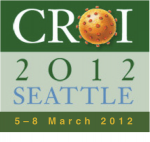Lower malaria risk in children receiving lopinavir/ritonavir-based compared to NNRTI-based ART
1 April 2012. Related: Conference reports, Paediatric care, CROI 19 (Retrovirus) 2012.
 Polly Clayden, HIV i-Base
Polly Clayden, HIV i-Base
Children with HIV in sub-Saharan Africa have significant morbidity and mortality risk from malaria. Interventions including bed nets and cotrimoxazole are not sufficient to decrease the risk in this population.
HIV and malaria parasites both encode aspartic class proteases, offering the possibility that HIV protease inhibitors (PIs) might have antimalarial properties. Furthermore, in vitro studies have demonstrated some activity against Plasmodium falciparum with PIs.
In an oral presentation, Jane Achan from Uganda presented findings from a study conducted by investigators from Makerere University College of Health Sciences and Infectious Diseases Research Collaborations in Kampala and the University of California, San Francisco, to compare the efficacy of lopinavir/ritonavir (LPV/r)-based and NNRTI-based ART regimens on malaria risk reduction in HIV positive children.
The study was a randomised open label trial of 170 children with a median age of 3 years of age (range 2 months to 6 years) conducted in Tororo, Uganda between September 2009 and July 2011. The children were either, ART-naïve (approximately 70%) and eligible for treatment, or receiving NNRTI-based ART and virologically suppressed (<400 copies/mL). They were randomised to receive either NNRTI- or LPV/r-based ART and followed for 2 years. All children received bed nets and cotrimoxazole and treatment for uncomplicated malaria with artemether- lumefantrine, the standard of care in Uganda and many African countries.
Following malaria diagnosis, the children attended the clinic on days 1, 2, 3, 7, 14, 21 and 28. Lumefantrine levels were measured on day 7 as this has been shown to be an independent predictor of malaria.
The analysis was ITT and the investigators compared the incidence of malaria between the study arms using Poisson regression. Dr Achan reported a 41% reduction in malaria associated with LPV/r-based ART, see Table 1.
| Malaria | NNRTI | LPV/r | |||||||
|---|---|---|---|---|---|---|---|---|---|
| Events | PYAR | Incidence | Events | PYAR | Incidence | IRR (95% CI) | p-value | ||
| All | 176 | 78.2 | 2.25 | 109 | 82.3 | 1.32 | 0.59 (0.36-0.97) | 0.04 | |
| Complicated episodes | 2 | 78.2 | 0.026 | 2 | 82.3 | 0.024 | 0.80 (0.06-11.16) | 0.87 | |
PYAR= person years at risk
When the investigators looked at possible explanations for this reduction, they found a 29% non-significant direct effect of LPV/r on the children’s first episode of malaria HR 0.71 (95% CI 0.45-1.12), p=0.14. An evaluation of the risk of recurrent malaria following treatment with artemether-lumefantrine, however, found LPV/r associated with a 54% reduction in risk HR 0.4 (95% CI 0.22 -0.76), p=0.004.
Median lumafantine levels on day 7 were 926 (IQR 473 – 1910) ng/mL vs 200 (IQR 108 – 510) ng/mL in the LPV/r vs NNRTI arms respectively, p<0.001, which Dr Achan explained might be associated with the boosting effect of ritonavir.
Dr Achan summarised the possible reasons for the lower risk observed in the LPV/r arm as follows:
- PK effect of LPV/r on lumafantrine leading to a prolonged post treatment prophylaxis effect following treatment with artemether-lumefantrine.
- Direct antimalarial effect of LPV/r.
- Antiparasitic synergy between LPV/r and lumafantine.
She concluded: “This study highlights the possibility of pharmacoenhancement as a tool for reducing the burden of malaria in highly endemic settings.”
comment
These data are interesting. Conversations after the session suggested that this study adds to the argument for recommending LPV/r- based ART for all infants and young children, but the issue of resistance was also raised with one drug in a combination having a prolonged half-life.
Ref: Achan J et al. Significant reduction in risk of malaria among HIV+ children receiving lopinavir/ritonavir-based ART compared to NNRTI-based ART, a randomised open- label trial. 19th CROI, 5–8 March 2012, Seattle. Oral Abstract 26.
http://www.retroconference.org/2012b/Abstracts/43194.htm

